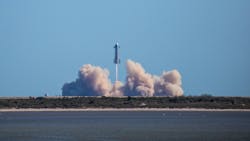SpaceX submits TPDES application amid alleged Clean Water Act violations
SpaceX submitted an application on July 1, 2024, to the Texas Commission on Environmental Quality (TCEQ) for a Treated Wastewater Discharge Permit (TPDES).
The permit is for the Starbase launchpad site in Brownsville, Texas.
A CNBC article stated that SpaceX received a notice from TCEQ about violations in early August and received a notice from the U.S. Environmental Protection Agency (EPA) on March 13, 2024, for Clean Water Act violations.
The CNBC article states that the SpaceX facility allegedly violated the Clean Water Act by “repeatedly releasing pollutants into or near bodies of water in Texas.”
SpaceX released a statement via X stating that the CNBC article was “factually inaccurate” and that TCEQ personnel were on site during the initial testing of a water deluge system.
The SpaceX statement also states that the EPA notice submitted in March 2024 was “done without an understanding of basic facts of the deluge system’s operation or acknowledgement that we were operating under the Texas Multi-Sector General Permit.”
The violations are focused on SpaceX’s water deluge system, which diffuses heat, sound and energy generated by rocket launches.
An investigation conducted by TCEQ and reported by CNBC state that SpaceX discharged industrial wastewater without a permit four times between March and July of 2024.
The TPDES application states that it is for a renewal to discharge 870 million GPD of once-through cooling water, auxiliary cooling water, and also authorizes the following wastewater streams monitored inside the facility before it is mixed with the other wastewater authorized for discharge via main Outfall 001.
The cooling water and boiler make-up water are supplied by Lake Starr Reservoir.
The city of Austin municipal water plant supplies the facility’s potable water and serves as an alternate source of boiler make-up water.
Water from the Lake Starr Reservoir is withdrawn at the intake structure and is treated with sodium hypochlorite to prevent biofouling and sodium bromide as a chlorine enhancer to improve efficacy and then passed through condensers and auxiliary equipment on a once-through basis to cool equipment and condense exhaust steam.
